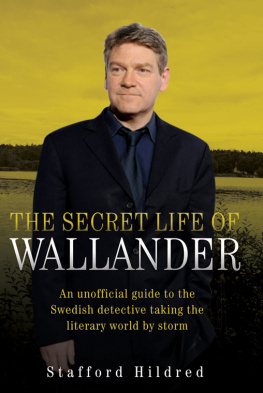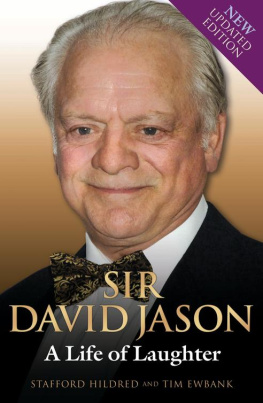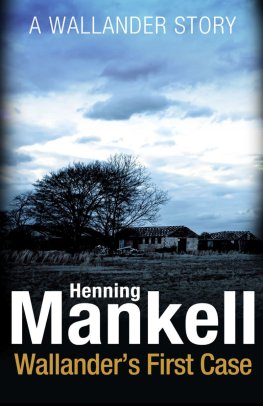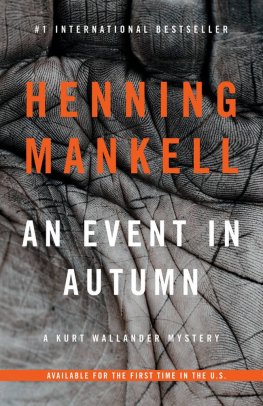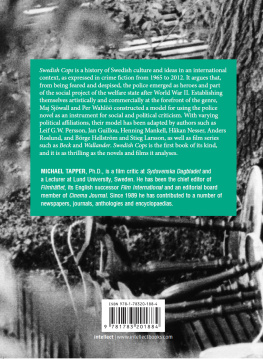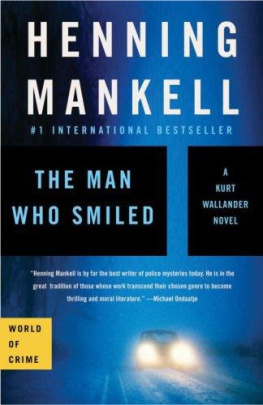CONTENTS
W hen it comes to fictional detectives, either in print or on screen, you might have thought we had seen everything. After all, among hundreds of variations weve had tough detectives, poetry-writing detectives, lollipop-sucking detectives, time-travelling detectives, priest detectives, a Chinese detective, a Dutch detective, a quadriplegic detective and even a singing detective. From the pages of some of the great crime novelists weve seen intrepid investigators like Sherlock Holmes, Miss Marple, Reginald Wexford and Maigret brought to life on our screens to solve the most compelling mysteries. But in recent years, after dear old Morse expired, Rebus retired, Jane Tennison screeched her last, Barnaby finally perfected his tree impression, and Frost simply melted away, a yawning gap at the top emerged for a compelling new-crime fighter. Step forward Kenneth Branagh as the Swedish policeman Kurt Wallander, who is helping to turn writer Henning Mankells dark and carefully crafted international best-sellers into a small screen success story.
The English-speaking Wallander first strode into action on British televisions in October 2008, as he marched into a field of bright yellow rapeseed in a desperate bid to help a terrified young girl who promptly poured petrol over her head and body and set fire to herself. It was an electrifying start to the first series of films and the excitement levels have scarcely faltered since. Kenneth Branaghs high quality version of Wallander is now a well-established, award-laden, audience-delighting winner and, happily, our troubled hero is going to be featuring prominently in our television schedules for years to come. Perhaps one of the most amazing things about Kurt Wallander is that it took him so long to arrive on our TVs to enthral us all.
It is more than two decades since Stockholm-born writer Henning Mankell created the small-town detective with a big-time following. In fact, it was back in May 1989 when Mankell, who was already a successful author, returned to Sweden from a lengthy spell in Africa. The passionate humanitarian was horrified by the rising xenophobia that seemed to have gripped his homeland while he had been away. Sweden had long had a proud record of warmly welcoming refugees from all over the world but Mankell detected a growing resentment against all immigrants. He wanted to write about this disturbing change in attitudes and he decided that, as xenophobia was a crime, he needed a police officer to take action. While crossword enthusiast Colin Dexter used the name of his favourite puzzle-setter for his great detective Morse, and P.D. James used the name of her English teacher for her police investigator Adam Dalgliesh, Henning Mankell was rather less sentimental. He picked the name Kurt Wallander out of the Stockholm telephone directory and drafted a dark and intriguing story about the vicious murder of an elderly couple, which is rumoured to have been carried out by foreigners.
That initial Wallander book, Faceless Killers, was first published in Sweden in 1991 and became enormously popular in Scandinavia and, soon afterwards, in Germany and other countries in mainland Europe. But it was not published in Great Britain until almost ten years later. By 1998, seven further Wallander novels had been published, mainly in Swedish and German, and had sold more than 30 million copies all over the world. They have been translated into at least 40 different languages, including Hebrew and Chinese. The greatest success has been in Germany, where Wallander comfortably outsells Harry Potter. Unfortunately, Wallander initially sold much less well in Great Britain and the United States than in other countries because the books were not translated into English until much later and also because they did not emerge at the bookshops in the right order. Wallander is very much a developing story but British and American readers found it difficult to fully appreciate this because of the bizarre publishing policy. And European audiences have already had the chance to see more than 20 Wallander films with several different actors taking the lead role. Actor Rolf Lassgrd is perhaps the best known Wallander on the continent, where the Swedes compare the film series to the James Bond movies and regard Lassgrd as the Sean Connery among rivals. But more recently Krister Henriksson has built up a significant following in Britain thanks to the BBC4 screenings of some of his Wallander films. His acting is certainly much more convincing than his improbable hair colour.
The action mainly takes place in and around the small Swedish seaside town of Ystad, population 17,000. In real life it is a very peaceful place where murder is an extremely rare occurrence. In fiction Mankell has brought more than 100 gruesome killings to the area and film units are an almost constant presence. The locals have learned to live with the fame Wallander has brought and apparently almost one-fifth of the population has appeared on screen in one film or another. Tourists come in their thousands to see the distinctive Wallander settings.
I had no idea this would be the start of a long journey, says Mankell. I was writing the first novel out of anger at what was happening in Sweden. The story came first, then the character. Then I realised I was creating a tool that could be used to tell stories about the situation in Sweden, and Europe, in the 1990s. The best use of that tool was to say, What story shall I tell? and then put him into it.
Kurt Wallander is very far from glamorous. From the start, Mankell presents his central character as lonely, morose and socially dysfunctional. His one joy appears to be listening to opera and he has a particular affection for Maria Callas. His wife, Mona, has walked out on him and he has lost touch with their only child, a headstrong 19-year-old daughter called Linda who tried to kill herself when she was a teenager. Wallander has a difficult relationship with his ailing and cantankerous elderly father, a painter who profoundly disapproves of his sons decision to become a policeman. When he first appears, Wallander is a sleeping policeman dreaming of making passionate love to a black woman. He is not just unhappy and frustrated, he is seriously overweight thanks to the unhealthy diet of hamburgers and pizzas with which he has sustained himself since his wife departed. In a bad way physically, he has put on seven kilos in the three months since Mona walked out. Neither Mankell nor Wallander minces words and our hero berates himself angrily as a flabby piece of shit.
It all sounds depressing and that is how Wallander so often feels, but he also has a shining integrity that sustains himself and his readers along with an unflagging determination to bring justice to an increasingly lawless world. Because of the brilliant way that Mankell lets us into the complex thought processes of his hero, we are with him all the way. And it is an enthralling and unforgettable journey. Seven more novels closely follow the first and Wallander plumbs the sort of depths of depression that make Inspector Morse seem like a laugh-a-minute, song-and-dance man. Wallander is lonely and unsure whether or not to remain in the police force. He knows he drinks too much whisky and eats too much unhealthy food but he does little about it. His relationship with his father is strained as the old man toils away endlessly on recreating the same landscape some 7,000 times. The symbolism of attempting to recreate a fondly remembered past is hardly subtle but it is still undeniably effective. Wallander Jnr goes on and on with more and more harrowing investigations into hideously violent crimes and becomes increasingly depressed by his life. After eight gloom-laden yet compelling books, Mankell gave

